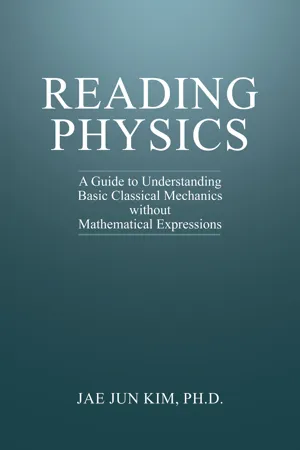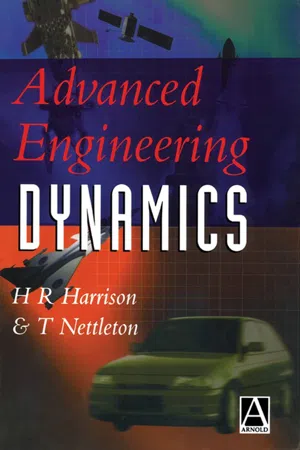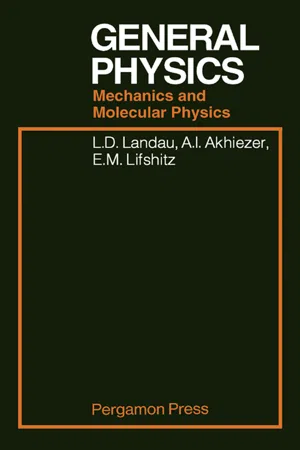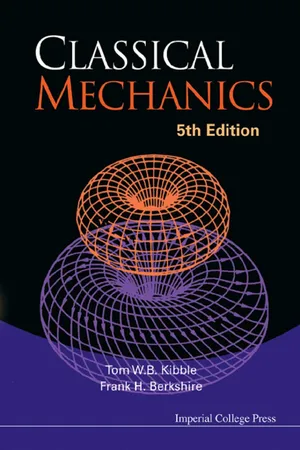Physics
Moment of Inertia
Moment of inertia is a measure of an object's resistance to changes in its rotation. It depends on the mass distribution of the object and the axis of rotation. The larger the moment of inertia, the more difficult it is to change the object's rotational motion.
Written by Perlego with AI-assistance
Related key terms
Related key terms
1 of 4
Related key terms
1 of 3
9 Key excerpts on "Moment of Inertia"
- eBook - ePub
- Michael M. Mansfield, Colm O'Sullivan(Authors)
- 2020(Publication Date)
- Wiley(Publisher)
Chapter 3 we noted that mass represents a measure of how a body responds to an applied force, in the sense that it proves more difficult to give a large mass a translational acceleration than it is to give a small mass the same acceleration. In the same sense Moment of Inertia represents a measure of how a rigid body responds to an applied torque; for example, it requires a larger torque to produce the same angular acceleration in a wheel of large radius than in a wheel of the same mass but of smaller radius.The SI unit for Moment of Inertia iskg m2.For problems based on the material presented in this section visit up.ucc.ie/7/ and follow the link to the problems.7.7 Calculation of moments of inertia: the parallel axis theorem
So far we have treated a rigid body as an assemblage of discrete particles. Alternatively we may wish to consider a rigid body as a continuous distribution of matter, in which case the body may be thought of as divided into a very large number of infinitesimal mass elements (The Moment of Inertia about a symmetry axis of a body which has a relatively simple geometrical shape can be determined without undue difficulty as demonstrated by the following examples.Δmin Figure 7.14 is one such element). The summations in Equations (7.10) and (7.11) are then replaced by integrals and the Moment of Inertia can be calculated by integrating over the whole body, that is , where r is the perpendicular distance from the element Δm to the axis. This is an example of a volume integral (Appendix A.12.4 ).For a continuous distribution of matter in a rigid body, the body may be thought of as comprising a very large number of mass elements ΔmFigure 7.14 - eBook - ePub
Reading Physics
A Guide to Understanding Basic Classical Mechanics without Mathematical Expressions
- Jae J. Kim(Author)
- 2023(Publication Date)
- Universal Publishers(Publisher)
Let us look at the colors. You might already have noticed that the items in light gray are ones that change as a function of time and the ones in gray are not. For instance, in a linear motion, the positions in the horizontal and vertical directions change, so they are colored gray. In a rotational motion, the size does not change, so it is colored gray. Given all that, here comes an important question. If angle is something that is going to change, but the distance and the mass are not, why not combine the ones that do not change together? Answer: That is exactly where we introduce the Moment of Inertia. In a rotational motion, the Moment of Inertia is not going to change as a function of time. In short, we can treat the Moment of Inertia just like we do mass in a linear motion.Remember that we do not always need to introduce the Moment of Inertia to describe rotational motion. It is just that introducing the quantity makes studying and understanding the rotational motion easier, so do so. We take the quantities that change as a function of time from the ones that do not change. When combining all the quantities that do not change, as colored in gray in Figure 33.1 , we end up with the Moment of Inertia in a rotational motion.How do we define the Moment of Inertia mathematically? It is mass multiplied by distance squared. Is that the end of the story? Probably not. For a test particle, it is as simple as that. If there is a point and if we are to describe its Moment of Inertia, that is all we need to understand. However, when calculating the size of the Moment of Inertia, we calculate the momentum of inertia for an individual piece of mass within the object and add them up together in the end, which is where we need to introduce calculus.For instance, the Moment of Inertia for a ring with respect to a line passing the center is just mass multiplied by the radius of the ring. However, when you do the same but for a solid sphere, an individual chunk of mass within the sphere has a different distance with respect to the center of the sphere, so we need to introduce calculus to calculate the total Moment of Inertia associated with the shape of the object; you do the same for any other object with a different shape.Figure 33.1: In a two-dimensional linear motion, we need two quantities in length and one in mass to describe its motion. In a rotational motion, what do we need instead?Figure 33.2: Imagine that we have a solid sphere that rotates with respect to an axis that passes through the center. The two small circles in the figure represent the two infinitesimally small pieces within the sphere. In terms of the displacement associated with the two small pieces per rotation of the sphere, the size of the displacement is going to be larger for the one that is farther from the axis, which is the one with the larger size arrow in light gray. Question: how do you accommodate for the difference in the distance to the rotational axis when calculating the size of the Moment of Inertia? We cannot simply assume that the Moment of Inertia is going to be simply the total mass times the radius squared. Why? All the small pieces shown in the figure have different sizes for distance. - eBook - ePub
- John Chiasson(Author)
- 2022(Publication Date)
- Wiley(Publisher)
5 Rigid Body Rotational Dynamics 5.1 Moment of Inertia The equation s of motion of a rigid body that is constrained to rotate about a fixed axis are reviewed here briefly. Consider the cylinder shown in Figure 5.1. Figure 5.1 Cylinder constrained to rotate about a fixed axis. The approach here is to obtain the equations of motion of the cylinder by first obtaining an expression for its kinetic energy. To do so, denote the angular speed of the cylinder by and the mass density of the material making up the cylinder by. Then consider the cylinder to be made up of a large number of small pieces of material where the th piece has mass This is illustrated in Figure 5.2. Each piece of mass is rotating at the same angular speed so that the linear speed of is where is the distance of from the axis of rotation. The kinetic energy of is given by Figure 5.2 Cylinder is considered to be made up of small masses The total kinetic energy is then Dividing the cylinder into f iner and finer pieces so that and, the sum becomes the integral The quantity is called the Moment of Inertia. Using the kinetic energy of the cylinder may now be written as Taking the axle radius to be zero, the Moment of Inertia of the cylinder (assuming the mass density is constant) is computed to be where is the total mass of the cylinder. 5.2 Newton's Law of Rotational Motion The kinetic energy is now used to derive a relationship between torque and angular acceleration. Recall from elementary mechanics that the work done on a mass by an external force equals the change in its kinetic energy - eBook - ePub
- H. Harrison, T. Nettleton(Authors)
- 1997(Publication Date)
- Butterworth-Heinemann(Publisher)
Equation 4.19 can now be written(4.20)Equation (4.18) gives(4.21)The differentiation is easy because the Moment of Inertia is a constant and shows that the moment of forces about O depends on the angular acceleration .We now return to the case of rotation about the fixed point. If we express the Moment of Inertia in terms of the fixed co-ordinate system it will no longer be constant because the orientation of the body will be changing with time. To avoid the difficulty of coping with a variable Moment of Inertia it is convenient to choose a set of moving axes such that the Moment of Inertia is constant. For the general case these axes will be fixed to the body but for the common situation where the body has an axis of symmetry we can use any set of axes for which one axis coincides with the axis of symmetry.This means that equation (4.18) will become (see equation (1.13) )(4.22)where ωR is the angular velocity of the moving axes.4.5 Moment of Inertia
In the previous section we found an expression for the Moment of Inertia about a fixed axis. Clearly different axes will produce different values for this quantity. We need to look at the formula for moment of momentum in some detail. For rotation about a fixed point we have, by equation (4.15) ,(4.15)Using the expansion formula for a triple vector product(4.23)From the appendix on tensors and dyadics we recognize that the second term is the product of the vector ω and a dyadic. The first term can be put in the same form by introducing the unit dyadic 1 so that equation (4.23) becomes(4.24)The terms in the square brackets are the Moment of Inertia. This quantity is not a scalar or a vector but a dyadic, or second-order tensor, and is given the symbol I so that equation (4.24) - No longer available |Learn more
- Robert A. Pelcovits, Joshua Farkas(Authors)
- 2023(Publication Date)
- Barrons Educational Services(Publisher)
7Rotation II: Inertia, Equilibrium, and Combined Rotation/Translation
Learning Objectives
In this chapter, you will learn:Calculation of Moment of Inertia for complex objectsParallel axis theoremAngular momentumNewton’s second law for rotational motion in terms of angular momentumConservation of angular momentumRolling without slippingStatic equilibrium for extended objectsRecall the definition of rotational inertia (where r is the distance between each differential mass and the axis of rotation).Definition of rotational inertiaCalculations of the rotational inertia for point masses, rings rotating about their axes, and cylindrical shells rotating about their axes (as shown in Figure 7.1 ) are straightforward because all the differential masses share a common r.Rotational inertia for point masses, rings, and cylindrical shells rotating about their axesWhat about more general objects where every differential mass does not share a common distance from the axis of rotation? In this more general case, we must proceed as we did with center-of-mass calculations for continuous masses: Divide the object into differential masses, calculate the rotational inertia of each differential mass, and sum these contributions to the total rotational inertia in an integral.Figure 7.1For one-dimensional objects, the differential regions consist of points (differential line segments). While it would also be perfectly valid to divide two- or three-dimensional objects into pointlike differential areas, summing these points would require double or triple integrals. As in center of mass calculations, to avoid the use of multiple integrals, we can divide two- or three-dimensional mass distributions into carefully chosen two- or three-dimensional differential regions. We must choose these two- or three-dimensional differential regions such that every particle of mass in a given differential region shares a common radius from the axis of rotation, allowing us to calculate the rotational inertia of the differential regions using the equation dI = r2 dm - eBook - ePub
General Physics
Mechanics and Molecular Physics
- L D Landau(Author)
- 2013(Publication Date)
- Pergamon(Publisher)
§12 that the kinetic energy of the system also falls into two corresponding parts. The “internal” motion is here represented by the rotation of the body about the centre of mass. The kinetic energy of a body moving in an arbitrary manner is thereforeThe suffix 0 signifies that the Moment of Inertia is taken about an axis through the centre of mass.E kin=1 2MV 2+1 2I 0Ω 2.[It should be noted, however, that in this form the result is of practical significance only if the axis of rotation has a constant direction in the body during the motion. Otherwise the Moment of Inertia has to be taken about different axes at different times, and is therefore no longer a constant.]Let us consider a rigid body rotating about an axis Z which does not pass through the centre of mass. The kinetic energy of this motion is , where I is the Moment of Inertia about the axis Z . On the other hand, we may regard this motion as consisting of a translational motion with the velocity V of the centre of mass and a rotation (with the same angular velocity Ω) about an axis through the centre of mass parallel to the axis Z . If the distance of the centre of mass from the axis Z is a , then its velocity V = a Ω. The kinetic energy of the body may therefore be written also asHenceE kin=1 2MV 2+1 2I 0Ω 2=1 2(M)a 2+I 0Ω 2.I =I 0+ Ma 2.This formula relates the Moment of Inertia of the body about any axis to its Moment of Inertia about a parallel axis through the centre of mass. It is evident that I is always greater than I 0 - eBook - ePub
- A. L. Stanford, J. M. Tanner(Authors)
- 2014(Publication Date)
- Academic Press(Publisher)
For example, if the rotation of a body in a problem takes place about a fixed axis, the problem involves pure rotation; we may then ignore any translational aspects of the rotating body. The kinetic energy of the body is then given by K = 1/2 I ω 2. If the system under consideration is a rigid body rotating about a fixed axis, any particle located at a distance r from the axis of rotation has translational displacement, tangential speed, and tangential acceleration related to its angular variables by s = r θ, v t = r ω, and a t = r α. If a rotating body in a problem is not rigid, that is, if the distances between particles that comprise the body change, the problem is probably one that utilizes the principle of conservation of angular momentum. Before we conclude that the angular momentum of a system is conserved, we must be certain that external forces produce no net torque on the system (the necessary condition for conservation of angular momentum). When angular momentum of a system is conserved, the equation I i ω i = I f ω f relates the angular velocities and moments of inertia of the system before (initially) and after (finally) the configuration has been changed to give the system a different Moment of Inertia. Rolling (or unwinding) bodies translate and rotate simultaneously. If they roll without slipping, the equations s = r θ, v t = r ω, and a t = r α relate the translational and rotational variables of points on or within the rolling body - eBook - ePub
- Tom W B Kibble, Frank H Berkshire(Authors)
- 2004(Publication Date)
- ICP(Publisher)
3 is completely arbitrary.9.5Calculation of Moments of InertiaThe moments and products of inertia of any body with respect to a given origin may be calculated from the definitions (9.15). For continuous distributions of matter, we must replace sums by integrals:etc., where ρ(r) is the density.Shift of originWhen the rigid body is pivoted so that one point is fixed, it is convenient to choose that point to be the origin. If there is no fixed point, we generally choose the origin to be the centre of mass. Thus it is useful to be able to relate the moments and products of inertia about an arbitrary point to those about the centre of mass.As usual, we shall distinguish quantities referred to the centre of mass as origin by an asterisk. To find the desired relations, we substitute in (9.15) the relation (8.16), r = R + r∗ , and use the conditions (8.17), namelyBecause of these relations, the cross terms between R and r∗ drop out, exactly as they did in (8.18) or (8.29). For example,The last term here is just the product of inertia I∗xyreferred to the centre of mass as origin. Thus we obtain relations of the formetc. Note that, as in previous cases, the components of the inertia tensor with respect to an arbitrary origin are obtained from those with respect to the centre of mass by adding the contribution of a particle of mass M at R. (For the moments of inertia, this is known as the parallel axes theorem.) Because of this result, it is only necessary, for any given body, to compute the moments and products of inertia with respect to the centre of mass; those with respect to any other origin are then given by (9.25).It is important to realize that the principal axes at a given origin are not necessarily parallel to those at the centre of mass. If we choose the axes at the centre of mass to be principal axes, then the products of inertia I∗xy, I∗xz, I∗yzwill all be zero, but it is clear from (9.25) that this does not necessarily imply that Ixy , Ixz , Iyz are zero. In fact, this will be true if, and only if, the chosen origin lies on one of the principal axes through the centre of mass, so that two of the three co-ordinates X, Y, Z - eBook - ePub
- David J. Peery(Author)
- 2013(Publication Date)
- Dover Publications(Publisher)
as defined by Eqs. 4.7 and 4.8 is called the centroid of the area.FIG . 4.2.FIG . 4.3.4.2. Moment of Inertia. In considering inertia forces on rotating masses, it was found that the inertia forces on the elements of mass had a moment about the axis of rotation ofas shown in Fig. 4.3 . The term under the integral sign is defined as the Moment of Inertia of the mass about the z axis.Since the x and y coordinates of the elements are easier to tabulate than the radius, it is frequently convenient to use the relationr 2 = x 2 + y 2orAn area has no mass, and consequently no inertia, but it is customary to designate the following properties of an area as the moments of inertia of the area since they are similar to the moments of inertia of masses.The coordinates are shown in Fig. 4.4 . The polar Moment of Inertia of an area is defined as follows:From the relationship used in Eq. 4.10,FIG . 4.4.FIG . 4.5.It is frequently necessary to find the Moment of Inertia of an area about an axis when the Moment of Inertia about a parallel axis is known. The Moment of Inertia about the y axis shown in Fig. 4.5 is defined as follows:substituting the relation x = d + x ′ in Eq. 4.15,orwhere represents the distance of the centroid of the area from the y ′ axis, as defined in Eq. 4.7, represents the Moment of Inertia of the area about the y ′ axis, and A represents the total area. Equation 4.16 is simplified when the y ′ axis is through the centroid of the area, as shown in Fig. 4.6 .The term I c represents the Moment of Inertia of the area about a centroidal axis.FIG . 4.6.FIG . 4.7.The Moment of Inertia of a mass may be transferred to a parallel axis by a similar procedure to that used for the Moment of Inertia of an area. For the mass shown in Fig. 4.7 , the following relations apply where the centroidal axis C lies in the xz plane.substituting ,Since x
Index pages curate the most relevant extracts from our library of academic textbooks. They’ve been created using an in-house natural language model (NLM), each adding context and meaning to key research topics.
Explore more topic indexes
Explore more topic indexes
1 of 6
Explore more topic indexes
1 of 4








